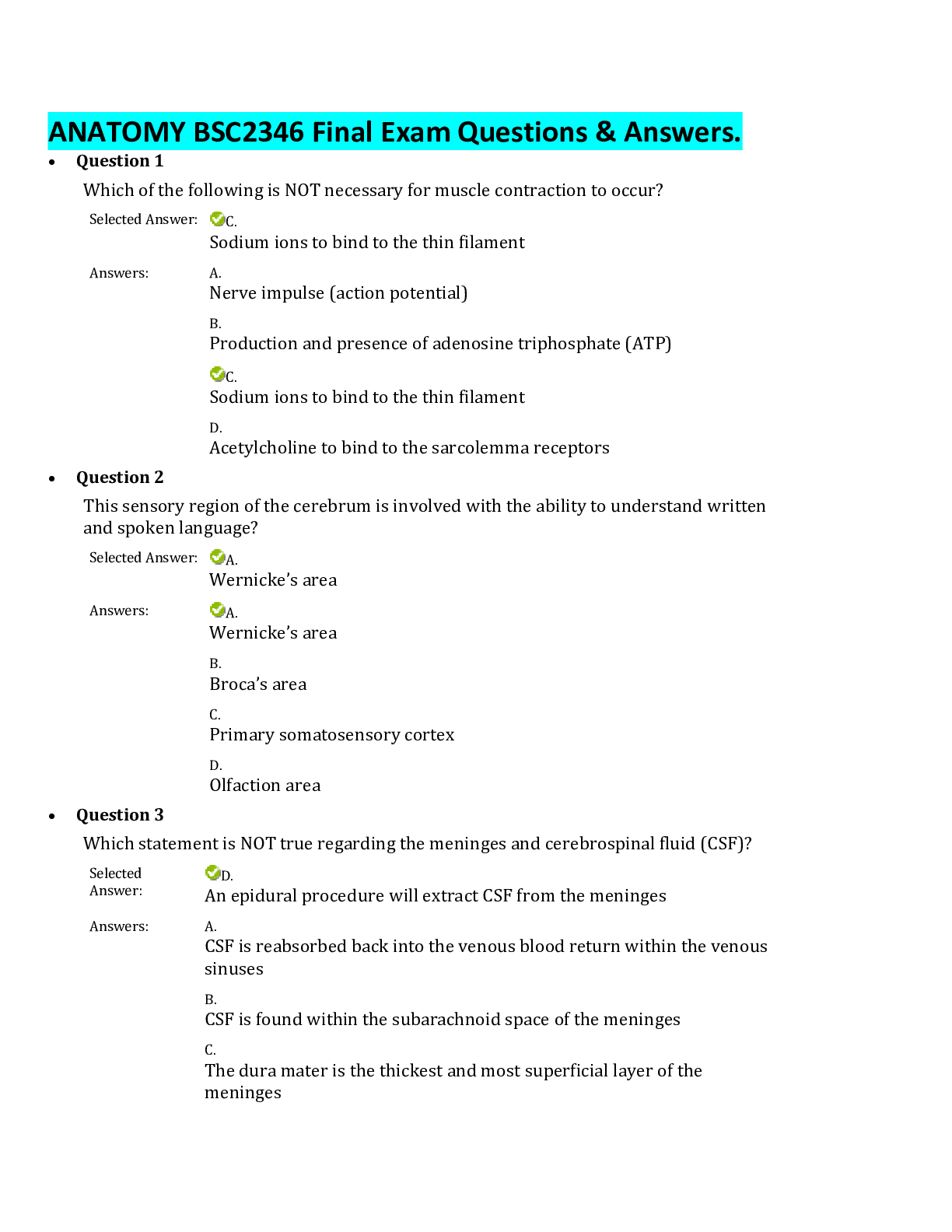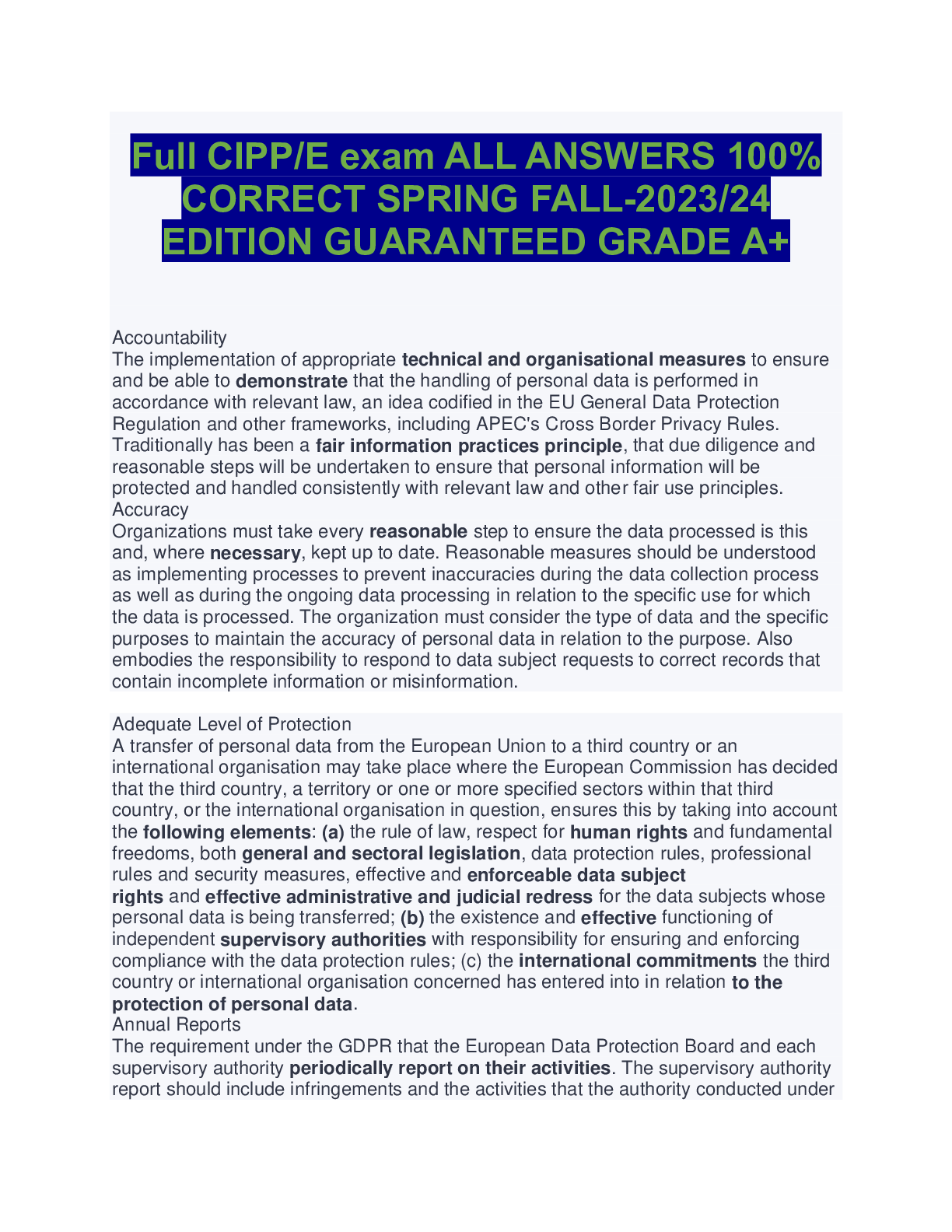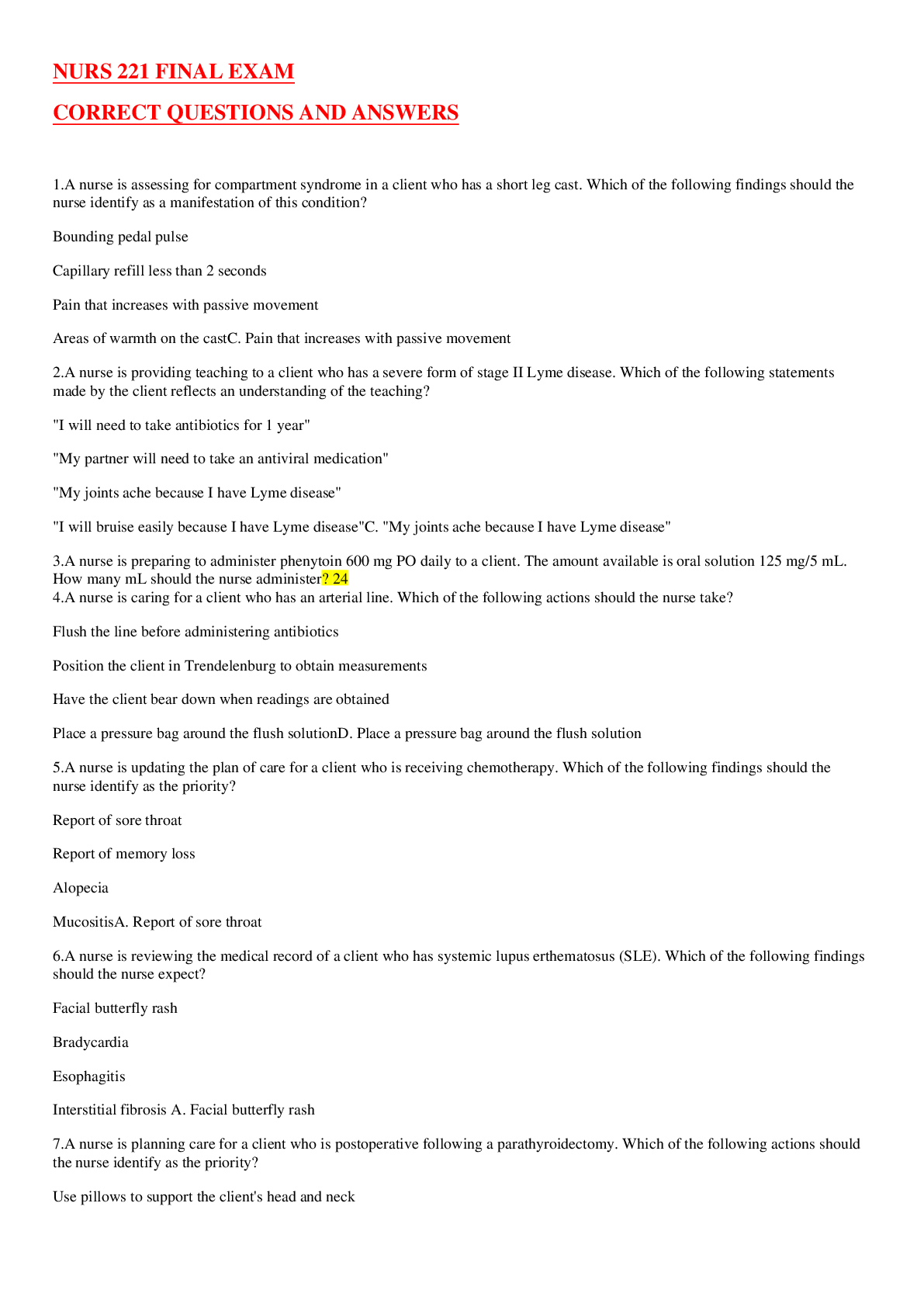Philosophy > EXAM > PHAR1821 - Pharmacy Practice EXAM ALL ANSWERS 100% CORRECTB SPRING FALL-2023/24 EDITION AID GRADE A+ (All)
PHAR1821 - Pharmacy Practice EXAM ALL ANSWERS 100% CORRECTB SPRING FALL-2023/24 EDITION AID GRADE A+
Document Content and Description Below
Medicine Evidence Based... Doctors/ medical professionals decide what is best for the patient The conscientious, explicit and judicious use of current best evidence in making decisions about th... e care of individual patients Requires the integration of individual clinical expertise with the best available external clinical evidence from systemic research and our patient's unique values and circumstances Practice Evidence Based... Doctors/ medical professionals decide what is best for the patient based on/ in accordance with the patient's request/wishes An approach to decision making in which the clinician uses the best scientific evidence available, in consultation with the patient, to decide upon the option which suits the patient best Patient is an active 'agent' in the decision-making process, collective discussion before a decision is made Phase 1 Clinical Trial Pharmacokinetics and toxicology trial → what happens to a drug in the body? Phase 2 Clinical Trial Different dosages and affect → what's the effect of different dosages? Phase 3 Clinical trial Effectiveness in comparison to standard therapies → is this better than what we've already got? Phase 4 Clinical trial Post-market monitoring → adverse effects, how does this affect various populations? Avicenna History of Drug Research and Evidence-based Medicines Drug must have a specific mode of action Must be tested on a well defined single disease Time of action must be observed The effect of the drug must occur constantly and not transient Testing a drug on a lion or a horse might be different from its effect on man Lind History of Drug Research and Evidence-based Medicines A Scottish physician, on board of HMS Salisbury, divided 12 sailors with scurvy into 6 groups of 2 sailors and given one of the following treatments: Cider Elixir vitriol Vinegar Seawater Nutmeg plus a mixture of garlic and mustard Fresh fruit (2 oranges and 1 lemon daily for 6 days) “Propose nothing dictated merely from theory; but shall confirm all by experience and facts, the surest and most unerring of guides” Recieving ... enquiries Enquirer → layperson v Health Care Professional Time available → immediate v Delayed Other → legal issues, ethical issues, consequences of response Classify ... enquiries Stability and compatibility Drug therapy (dose/indication etc) Specific therapy areas (for extra information) Antibiotics, psych, renal, paediatric, neonatal, oncology, immunisation, haematology Formulae Drug interactions Foreign medications Complementary medicines Adverse drug reactions Search strategies Enquiries Develop a search strategy based on the enquiry Perform search strategy Ensure validity of information acquired Check reference Time of update Multiple references searched Tertiary Information sources an index or textual consolidation of primary and secondary sources - textbooks, review articles e.g. AusDI, MIMS online, AMH, eTG, MedicinesComplete etc Secondary Information sources document or recording that relates or discusses information originally presented elsewhere - Abstracts, databases Large databases → electronic searching essential Type of database Searching system used Controlled vocabulary Thesaurus Term combining → BOOLEAN operators (e.g. using 'and' or 'or') Primary Information sources Serves as an original source of information about the topic - original research publications NMP; National medicines policy Quality use of medicines→ how do you ensure that a patient is able to use their medicines correctly, appropriately and safely? Provide appropriate advice and counselling to people around health, disease and medicine specific questions PSA Competency Standards Communicate respectfully and with tact Express thoughts clearly Use a communication style appropriate to the audience and the material Check that information provided has been received and understood Communication skills Establish rapport with your patients (and colleagues) Effective listening skills Be able to ask open ended questions, and know when they are appropriate Asked closed questions appropriately Be able to summarise information received and given Use lay language Appropriate non-verbal language Demonstrate empathy Communication Conferring through speech, writing, or non-verbal means (including body language) to create a shared meaning 2 way process→ ensuring that they understand you and you have understood them Effective communication: when what people intended to say has been heard and the people involved have reached a point of shared meaning Just because you have said it doesn't mean that the person has heard and understood it Poor communication Ignores customer calling out for assistance Talks to another pharmacist whilst the customer is talking, multiple times Questions whether the customer has heartburn, comparing it his own experience Talks over the customer when she is giving him details of the patient Asks the customer questions about the pain, despite her trying to tell him that it's not for her, and repeatedly asks without waiting for an answer→ poor questioner Makes negative comments about a customer to another pharmacist as if she is not there Inappropriate, unfriendly body language: hands on hips, leans on the table, hands up to assert superiority and to say that she is the one not listening Missed her non-verbal cues of feeling ignored Failed to summarise back to the patient what was heard, poor listener Professional Relationship type Planned, formal- (e.g. specific health issues)Adaptive to the client's needs Educational Often brief and short term, can be superficial Uses technical language Often less self disclosure Different boundaries to a friendship, i.e. confidentiality ethical and privacy issues covered by law Potential power imbalance Social Relationship type Spontaneous or planned Focused on your needs, not the pharmacists (e.g. cheaper for patient, not more money for pharmacy) Language less formal, technical but can be jargonised, i.e. use of text (c u @ 6) Often involves a deeper level of self disclosure and intimacy Can last for many years Choice, you can't choose your patients Agressive Behavioural style Does not respect rights, beliefs, values of others Physically and/ or verbally dominating→ verbal and body language E.g. interrupts, loud, ‘stand-over’ tactics, blames, criticizes, threatening Example: What would an aggressive senior pharmacist speaking to a junior pharmacist who has made a dispensing error sound and look like? What sorts of things would they say? Questions what the junior knows Blame the junior without hearing what happened Demeaning, rude language: e.g. you’re never going to be a good pharmacist Yelling, invade personal space Assertive Behavioural style Respects rights beliefs, values of self and others Use ‘i’ statements Expect to be respected and respects others Willing to communicate ‘Own’ their feelings and ideas Example: What would an assertive senior pharmacist speaking to a junior pharmacist who has made a dispensing error sound and look like? What sorts of things would they say? Asks what went wrong Figures out how they can help their junior learn for next time “I'd like to find out what's happened and how i can help you prevent this from happening again” No blaming, though will be more assertive to them doing wrong if it occurs repeatedly Passive Behavioural style Belief that do not have the right to express own thoughts and beliefs Will 'do as told' Allow others to make decisions/choices Active listening Body language Eye contact ‘Interest’! (alertness, focus on patient) Open body (e.g. no crossed arms) Smiles, looks of concern where appropriate a careful and attentive listener Picks up differences in words vs body language Reads ‘between the lines’ Can identify and summarise (paraphrase) key points Summarising/ Paraphrasing Ensures that patient and pharmacist are on ‘the same page’ E.g. “so just let me check that i’ve got this right… you’ve been having these symptoms for about a week and the pain has slowly worsened, especially when eating since you started this new medication” Empathy Crucial to building effective therapeutic alliance Involves an ‘attitude’ as well as ‘action’ Not the same as sympathy (don’t pity them) Attitude To attempt to share the experience of the other Some emotional identification with the experience Non-judgemental and non-evaluative To be genuine To be open to the experience of others Action Communicate your understanding Active listening: asking open ended questions, conveying interest and concern, acknowledging concerns Provide active and practical support where possible Problem solve issues; e.g. Home delivery of medicines if patient/ carer incapacitated Referral to community health centre/ physician Organisation of hire of aids etc. not available through your pharmacy Open questions Open ended Encourage patient to respond in their own way Encourage elaboration and help people to expand on what they have said Useful when gathering information about the patient’s ‘story’ Examples “Tell me about any over the counter medicines you are taking now” “Describe your symptoms” “Tell me about the hay fever medications you’ve used in the past” “Apart from medications, what else do you currently do to help your headaches?” Note: avoid ‘why’ questions → criticism, value judgement Close questions A question which is direct and close-ended Requires single word reply by respondent (e.g. yes/no) Enables the provision of specific information Good to ask at the end of the interaction Be careful → can ‘prevent’ patients from disclosing accurate information, e.g. “Do you know how to use your nasal spray?” INSTEAD → “If you have your puffer with you, could you please show me how you use it?” Examples “Are you taking any medications at the moment?” “What type of antihistamine do you currently use?” “How long have you been using this?” Benefits ... of patient-focused communication Patients will come back, trusting the pharmacist and feeling understood All of the patient's questions have been answered Patient is informed more of their disease and how different medications could help them Skills checklist Introduces self Puts the focus of attention on the speaker Demonstrates attentive body language Uses open ended questions Uses closed questions Avoids judgemental comments Demonstrates patience Does not talk about themselves Summarises what has been said Repeats final instructions/ decisions WWHAM Assessment questions W → Who is the patient? W → What are the symptoms? H → How long have the symptoms been presented? A → Action taken? Allergies? M → Medication being taken? Medical history? WWHAM analysis Advantages and Disadvantages Establishes the presenting complaint and what the patient has done about it Fails to consider General appearance Social/ lifestyle factors Family history Previous symptoms Doesn’t provide information to ensure safe supply Literature→ WWHAM protocol correlates with appropriate non-prescription medication supply in the UK, more questions= more appropriate outcomes ASMETHOD Assessment questions A→ Age/ appearance S→ Self or someone else? M→ Medication? E→ Extra medicines? T→ Time persisting? H→ History? O→ Other Symptoms? D→ Danger Symptoms? What Stop Go Assessment questions Who is the patient? How long have symptoms been present? Actual symptoms – what are they? Treatment for this or any other condition? Symptoms or side effects caused by other conditions/meds? Totally sure – any special patient needs or circumstances? Overuse/Abuse – how often has the patient been taking the medication or self-treating? Pharmacist Only – always refer to the pharmacist. GO – supply medicine if appropriate and provide advice ASMETHOD analysis Establishes presenting complaint, AND if the patient has had it before Exact symptoms and severity? No social/ lifestyle factors? Family history? Sit Down Sir S→ Site or location I→ Intensity or severity T→ Type or nature D→ Duration O→ Onset W→ With? (other symptoms) N→ Annoyed or aggravated (????) S→ Spread or radiation I→ Incidence or frequency, pattern? R→ Relieved by? Sit Down Sir analysis Establishes severity, nature and previous history More details elicited? No social/ lifestyle factors? Family history? Does not consider general appearance communication barriers The physical environment Counters Beds Noise/interruptions Pharmacist Attitudes and prejudices Poor communications skills Patient Attitudes, lack of knowledge or understanding Communications skills Interruptions Other patients Staff Phones Prescriptions pressure Communication solutions Come out from behind the counter Sit next to the bed, don't stand Privacy?? Find a corner Draw the curtain Sit down if at all possible for counselling 'One thing at a time' Pharmacist barriers Disinterest Devalues efficacy of good communications skills Lack of confidence Absence of skills Lack of practice Time/other work pressures Embarrassment talking about sensitive/ personal issues Jargon Communicating with patients who are cognitively impaired Temporary or permanent impairment Mental health (depression; schizophrenia) Pharmacist solutions Get comfortable The more you talk about it the less embarrassed you will be Get informed Learn about how mental health issues, stroke or dementia can impair patient cognition Use communication aids Verbal + written Include carers/family members Patient barriers Poor interpersonal skills in communication Too busy/in a rush Does not perceive potential value of pharmacist based care Physical/intellectual/social disabilities Language difficulties Literacy Health literacy Patient solutions Adopting a patient-focused approach to communications helps to prevent the patient Feeling they are wasting your time Omitting details they deem unimportant Embarrassment at mentioning things they think will place them in an unfavourable light Not understanding medical terms Believing you haven't really listened Care [Show More]
Last updated: 1 year ago
Preview 1 out of 83 pages

Reviews( 0 )
Recommended For You
History> EXAM > HIEU 201 Western Civilization 1 Chapter 12 Quiz- Liberty University | Complete Answers. All Answers 100% Correct (All)

HIEU 201 Western Civilization 1 Chapter 12 Quiz- Liberty University | Complete Answers. All Answers 100% Correct
HIEU 201 Chapter 12 Quiz Liberty University | Complete Solution 1. Among the consequences of the Black Death were 2. In the Late Middle Ages 3. Peasant rebellions broke out...
By Expert#1 , Uploaded: Jan 05, 2020
$8.5
Anatomy> EXAM > ANATOMY - BSC2346 Final Exam Questions & Answers, Latest all answers 100% correct; Rasmussen College. (All)

ANATOMY - BSC2346 Final Exam Questions & Answers, Latest all answers 100% correct; Rasmussen College.
ANATOMY BSC2346 Final Exam Questions & Answers. • Question 1 Which of the following is NOT necessary for muscle contraction to occur? C. Sodium ions to bind to the thin filament A....
By Expert#1 , Uploaded: May 14, 2020
$15
Database Management> EXAM > Full CIPP/E exam ALL ANSWERS 100% CORRECT SPRING FALL-2023/24 EDITION GUARANTEED GRADE A+ (All)

Full CIPP/E exam ALL ANSWERS 100% CORRECT SPRING FALL-2023/24 EDITION GUARANTEED GRADE A+
Accountability The implementation of appropriate technical and organisational measures to ensure and be able to demonstrate that the handling of personal data is performed in accordance with relevant...
By Allan100 , Uploaded: Nov 15, 2022
$8
*NURSING> EXAM > PATHOPHYS Module Exams ALL ANSWERS 100% CORRECT SPRING FALL-2022 LATEST SOLUTION GUARANTEED GRADE A+ (All)

PATHOPHYS Module Exams ALL ANSWERS 100% CORRECT SPRING FALL-2022 LATEST SOLUTION GUARANTEED GRADE A+
Module 1 Exam Question 1 2.5 / 2.5 pts True/False: A bodybuilder’s muscles will display hyperplasia. True Correct! False It will display hypertrophy. Question 2 2.5 / 2.5 pts True/False: B...
By Allan100 , Uploaded: Aug 04, 2022
$13.5
Biology> EXAM > BIOD 171 Final Exam with all answers 100% correct (All)

BIOD 171 Final Exam with all answers 100% correct
True/False. A virus is classified as a microbe. - ANSWER True True or False: The smallest biological unit of life is the molecule. - ANSWER False -smallest unit of life is the cell. At a general...
By Nancylect , Uploaded: Aug 02, 2022
$7
Statistics> EXAM > CS 234 assignment 2-ALL ANSWERS 100% CORRECT Study Guide (All)

CS 234 assignment 2-ALL ANSWERS 100% CORRECT Study Guide
CS 234 assignment 2-ALL ANSWERS 100% CORRECT Study Guide
By MARKALLAN , Uploaded: Aug 01, 2022
$5
Statistics> EXAM > CS 234 assignment 2 ALL ANSWERS 100% CORRECT Study Guide (All)

CS 234 assignment 2 ALL ANSWERS 100% CORRECT Study Guide
CS 234 assignment 2 ALL ANSWERS 100% CORRECT Study Guide
By MARKALLAN , Uploaded: Aug 01, 2022
$5
Statistics> EXAM > CS 234 assignment 2 ALL ANSWERS 100% CORRECT Study Guide (All)

CS 234 assignment 2 ALL ANSWERS 100% CORRECT Study Guide
CS 234 assignment 2 ALL ANSWERS 100% CORRECT Study Guide
By MARKALLAN , Uploaded: Aug 01, 2022
$5
Medicine> EXAM > PTCB Exam Study Guide 2022-2023 with all answers 100% correct (All)

PTCB Exam Study Guide 2022-2023 with all answers 100% correct
Dosage of Controlled Substances - ANSWER *Hydrocodone/Acetaminophen* Hydrocodone: Range in strength from 2.5 to 10mg Acetaminophen: Range in strength from 325mg to 650mg Lorazepam: Total of 6mg e...
By MARKALLAN , Uploaded: Jul 30, 2022
$8
Health Care> EXAM > ATI RN MEDSURG yetty questions ALL ANSWERS 100% CORRECT FALL-2021 SOLUTION GUARANTEED GRADE A+ (All)

ATI RN MEDSURG yetty questions ALL ANSWERS 100% CORRECT FALL-2021 SOLUTION GUARANTEED GRADE A+
A nurse is assessing for compartment syndrome in a client who has a short leg cast. Which of the following findings should the nurse identify as a manifestation of this condition? A. Bounding pedal...
By Crum , Uploaded: Jul 27, 2022
$15
Document information
Connected school, study & course
About the document
Uploaded On
Jan 16, 2023
Number of pages
83
Written in
Additional information
This document has been written for:
Uploaded
Jan 16, 2023
Downloads
0
Views
47






